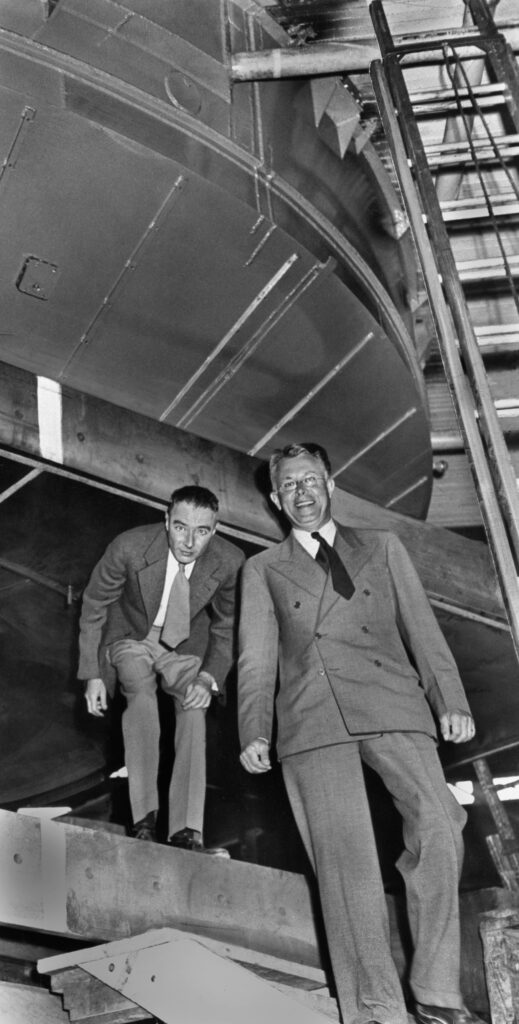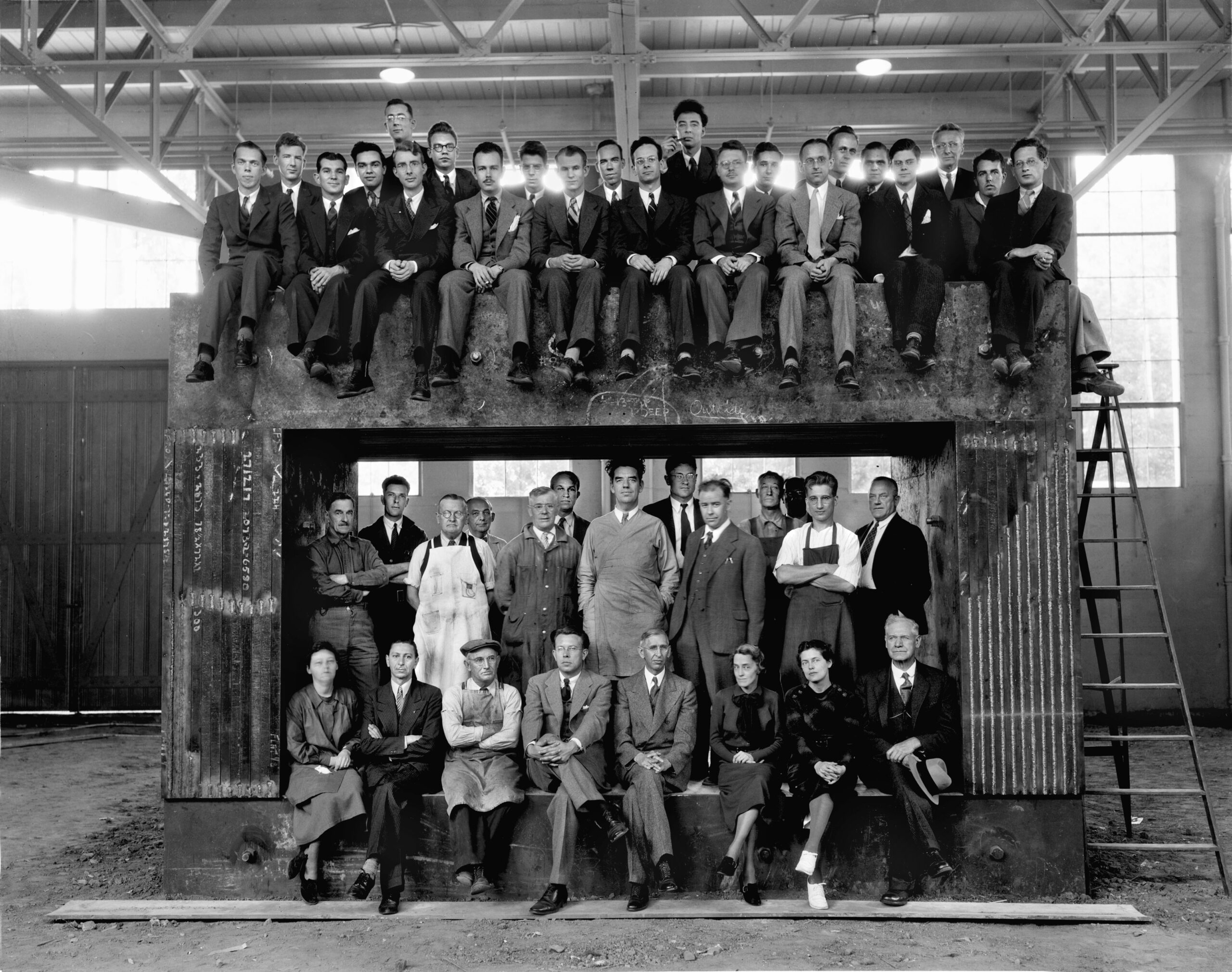Michael Hiltzik. Big Science: Ernest Lawrence and the Invention That Launched the Military-Industrial Complex. Simon and Schuster, 2015. 528 pp. $30.
On April 26, 1954, nuclear physicist Ernest O. Lawrence phoned Lewis Strauss of the Atomic Energy Commission (AEC) to inform him that he couldn’t testify against his colleague and one-time friend J. Robert Oppenheimer, despite his earlier pledge to do so. Strauss, who led the hearings exploring Oppenheimer’s background and associations, was none too happy with Lawrence’s change of heart.
Lawrence and Oppenheimer had worked together at the University of California, Berkeley, and, more famously, on the Manhattan Project. Lawrence even named one of his sons Robert after Oppenheimer. But Lawrence had grown exasperated by Oppenheimer’s vocal support for a public debate on U.S. nuclear policy—a debate that could impede Lawrence’s efforts to expand the American nuclear program.
In truth, Lawrence’s second thoughts about testifying were not out of concern for a former friend but for his radiation laboratory. Lawrence feared the reputation of his Rad Lab, as it was known, would suffer if he participated in the AEC’s private hearing to remove Oppenheimer’s security clearance, widely viewed as a witch hunt by the physics community. So the day before he was due to testify, Lawrence called Strauss and told him he was too sick to make the journey from California. It was the truth—Lawrence was suffering from one of his recurring bouts of ulcerative colitis, likely caused by intense stress—but it was not the whole truth.
Although Lawrence did not testify in person, a transcript of an interview he gave condemning Oppenheimer was presented at the hearing, and it included the words “[Oppenheimer] should never again have anything to do with the forming of policy.” Several other members of Lawrence’s lab team also testified against Oppenheimer, including Luis Alvarez, Wendell Latimer, and Kenneth Pitzer, apparently united against their colleague and the idea of political dissent in the scientific community.
Lawrence’s reputation and that of his laboratory never fully recovered from his involvement in Oppenheimer’s persecution, despite Lawrence’s considerable contributions to nuclear physics and his status as a Nobel laureate.
In Big Science: Ernest Lawrence and the Invention That Launched the Military-Industrial Complex, Michael Hiltzik depicts Lawrence as a man of unique strengths and inescapable weaknesses. As the title suggests, Lawrence’s strengths perfectly positioned him to transform the way science, particularly nuclear physics, was done, from benchtop experiments in small, ill-equipped, and understaffed labs to large-scale experiments in government-funded labs with big teams of scientists and even bigger equipment. But despite this scientific success Lawrence’s flaws tripped him up throughout his career. He learned to compensate for some of his weaknesses, but he couldn’t escape them all.
Lawrence’s education did not follow the typical path of East Coast elites in the nuclear-physics field. He grew up in a fairly conservative, if intellectually encouraging, household in South Dakota. His parents, the children of Norwegian immigrants, were both teachers. He earned his bachelor’s degree at the University of South Dakota and his master’s degree at the University of Minnesota, and then headed east to Yale University for his doctorate. In 1928 Lawrence was recruited by the University of California, Berkeley, at the time somewhat of a backwater in research. Four years later he invented the cyclotron, which Hiltzik describes as a “method for artificially driving subatomic particles into the nucleus with enough energy to give physicists a clear picture of what it was made of.” One cyclotron led to another, each larger and more powerful than the last. Lawrence’s use of big equipment and big teams of scientists, who were needed to keep the cyclotrons running, was atypical for the field. Hiltzik points out that the father of nuclear physics, Ernest Rutherford of the University of Cambridge’s Cavendish Laboratory, distrusted the cyclotron and believed that great discoveries could still be made with simple tabletop equipment. Lawrence transformed this romantic notion of the lone, scrappy scientist working in his tiny lab into that of big science.
Lawrence encouraged an atmosphere of collaboration in the Rad Lab, unlike the standard practices in Europe and the rest of the United States. Each member of his team focused on one chemical element, bombarding that element’s nucleus, while Lawrence acted as overseer. He encouraged curiosity and exploration for their own sake and recruited team members from chemistry, medicine, and engineering as well as physics. His skill in attracting talent was matched by his skill in finding the money to pay that talent.

Robert Oppenheimer and Ernest Lawrence standing by a 184-inch cyclotron, ca. 1946. The pair, who had worked closely together in Lawrence’s lab and on the Manhattan Project, would become estranged because of their political differences.
To illustrate the unusual nature of Lawrence’s rainmaking abilities, Hiltzik offers up Marie Curie and the lengths to which she went to obtain a tiny amount of radium in 1921. Curie had to “sing for her supper.” She went on a fund-raising tour of the United States for six weeks, finishing up with a visit to the White House, all to obtain just a thimbleful of radium for her experiments. Lawrence, however, created a trifecta of steady income from academia (through Berkeley), government, and foundations.
Lawrence’s interdisciplinary style of research actually increased the number of potential funders. When he discovered that foundations, including the Josiah Macy Jr. Foundation, were interested in funding the use of isotopes in cancer research, he tailored his pitch to them. Lawrence also understood the need for a little spectacle, and on his 1935 East Coast lecture tour—a thinly veiled fund-raising campaign—he drank a glass of radioactive salt water at each stop and then used a Geiger counter to demonstrate the radioactive sodium’s circulation throughout his body. He referred to these kinds of activities as “the vaudeville.”
Sometimes Lawrence’s personal traits led him astray. Early in his career a discovery might so excite him that he would fail to do the careful work required to confirm his results. At the 1933 World’s Fair in Chicago, Lawrence used his cyclotron observations to suggest that deuterons could explode when hit hard enough, which directly challenged research coming out of the Cavendish, the place where artificial nuclear fission had first been discovered. After the New York Times and Time published pieces on Lawrence and his new theory, the Cavendish tested it and disproved it. They found, as Hiltzik bluntly puts it, that “Lawrence’s targets were contaminated—his supposed great discovery the product of poor technique.”
Lawrence refused to believe his theory was faulty, continuing to promote it until his childhood friend Merle Tuve, also a renowned physicist, checked his results. “Dear Ernie,” Tuve wrote, “we reached the astounding conclusion that we were unable to check a single one of the observations which you have reported.” Lawrence was forced to admit his error. To add insult to injury, scientists at the Cavendish discovered two new isotopes—tritium and helium-3—while performing the same experiments.
After more such mistakes Lawrence learned his lesson and, according to Hiltzik, reoriented his laboratory “toward much more careful research.” Lawrence’s efforts paid off when he found a new radioactive isotope of sodium in 1934. Rather than rushing to make an announcement, Lawrence painstakingly reviewed his work and detailed his methodology in a long report sent to the journal Physical Review. His work was of great use for research in the physics and medical communities, and his more mature approach buoyed his reputation.
Lawrence went on to win the Nobel Prize in Physics in 1939 for the creation of the cyclotron and for the discoveries he made with his machine. Still, his inability to correct for all his habits of mind led to some serious professional mistakes, including his consistent advocacy for keeping politics out of the Rad Lab. Lawrence believed scientific work to be removed from the political realm, and he did not approve of his staff discussing politics in the lab or having opinions about the political implications of their research. Lawrence felt scientific activism led to “frittering away so much time and energy on political problems, when [the scientists] could be devoting themselves to scientific pursuits.” But Lawrence’s career took him through the Great Depression, World War II, and the Cold War, and he alienated many talented scientists who weren’t willing to keep politics out of their lives.
Despite his assertions Lawrence was not truly apolitical. The funders who kept his cyclotrons running and with whom he rubbed shoulders were often very conservative men, and they influenced him. When Lawrence received a government Works Progress Administration (WPA) grant during the Depression to hire out-of-work shop craftsmen, many of his private foundation funders balked at the idea of being associated with a New Deal program. Ludwig Kast of the Macy Foundation, one of his largest funders, worried that if the WPA was overturned by the Supreme Court, the foundation’s and the WPA’s dual support of the Rad Lab would be incriminating and indicate “that [the foundation has] something to do with sinister communist tendencies.” In response, Lawrence removed all acknowledgment of WPA funds from research papers involving work supported by the Macy Foundation.
Despite his great success in executing his big scientific ideas, Lawrence failed at managing his lab in this one way: he could not keep politics out.
In 1947, with McCarthyism under way, the California legislature’s Un-American Activities Committee began to investigate security at Berkeley, considered a sanctuary for leftists by committee members. Their concerns moved the AEC, under pressure from the House Un-American Activities Committee, to form regional security boards. Jack Neylan, a personal friend and patron of Lawrence’s and a regent at the university, headed the board at Berkeley and began investigating members of the faculty for Communist sympathies. Lawrence did not view these investigations as a systemic problem: he “accepted the rules, focusing his efforts on a defense of the accused rather than an attack on the system.” He saved a number of Rad Lab staffers from being fired by acting as a character reference, but he would not speak out against the investigations themselves. His primary motivation in getting involved was to keep his team intact. Outside of the Rad Lab he stayed away from the government’s inquisition. Frank Oppenheimer, Robert’s brother and a former Rad Lab staffer, was accused of Communist activity while working at the University of Minnesota, in a post for which Lawrence had heartily recommended him. Lawrence refused to let Frank visit the Rad Lab while he was under suspicion and even asked a mutual friend to rescind a dinner invitation to him. The accusations eventually cost Frank his job.
By 1949 anti-Communist pressure had escalated, and all Berkeley appointees were required to take an oath that they disavowed the Communist Party and did not support “any party or organization that believes in, advocates, or teaches the overthrow of the United States Government.” This demand outraged many of the faculty, especially those who were immigrants and had lived under totalitarian regimes in Europe. What Lawrence saw as “byzantine quibbles,” members of his team saw as a violation of academic freedom. When physicist Gian-Carlo Wick declined to take the oath, Lawrence argued with him; Wick refused to back down, and Lawrence told him to “get the hell out of the Rad Lab.”
Those who refused to sign the oath were dismissed. Many of the people who did sign began to look for other positions, as their once creative, open environment had soured. In the end the Rad Lab lost vital talent.
Four years later Lawrence’s testimony led to the removal of Robert Oppenheimer’s security clearance. The physics community did not look kindly on Lawrence’s involvement. As Hiltzik writes, “A great deal of obloquy fell on [him] and his colleagues at the Rad Lab, who had stood united, and virtually alone, against Oppenheimer.” Despite his great success in executing his big scientific ideas, Lawrence failed at managing his lab in this one way: he could not keep politics out.




